by Dennis Dalman
The St. Joseph Area Historical Society is like a homeless orphan, still looking longingly for a place to call home.
Its artifacts have been patiently and lovingly collected for many years, but now all of them are in storage here, there and elsewhere. As a result, members of the public and diehard history buffs cannot go to one particular place, to view and ponder the artifacts that bring the city’s history vividly to life.
That is why there is a concerted effort underway to find the “orphan” a permanent home, whether it be in a new building or in a remodeled, refurbished older building.
The late Andy Loso, a passionate St. Joseph history enthusiast, was only 42 when he died last year in the St. Cloud Hospital. Since his passing, his widow, Lisa, and others, including Andy’s mother, Linda, are trying to find a new home for the historical society, partly in honor of Andy, partly because they want residents to connect with the city’s history by way of the items in its collection. It contains old documents, photographs, personally written histories and diaries, the schools, the Catholic church smack dab in the heart of the city, farm implements, old-fashioned toys, military uniforms, and so much more.
Founded in 2002, the historical society was located on the second floor of the First State Bank of St. Joseph. However, three years later, it had outgrown that locale and was moved to a vacant city-office building at 25 First Ave. N.W., just south of downtown. Thirteen years later, in 2018, it was moved again to the former Kennedy Elementary School after a new school was built. There it stayed until 2021 and had to move out when the school building was purchased. That is when it became “homeless,” its treasure trove of artifacts having to be stored in people’s homes, attics, garages and elsewhere.
Local historian Marilyn Salzl Brinkman said it best in a feature story she wrote several years ago for the St. Joseph Newsleader.
“Everybody has a story to tell,” she wrote. “Everybody’s story is important. Your local historical society is the place to begin, the place to preserve those stories for future generations. Wouldn’t you like to know more about your hometown, your extended family, your grandparents, their lives, their joys, their hardships – their history?”
Salzl Brinkman is one of many St. Joseph residents, including the Losos, trying to find a home for it.
“A search for a new home is underway,” she wrote. “A place where the historical society can store and preserve its precious treasures, its files, family photographs, business records, sports and city documents and stories, as well as military uniforms and items from several wars.”
She noted that preserving the ever-expanding collection is important because it has a big part in educating young people and reminiscing together with others about a common past.
Besides a new home, the historical society is always seeking volunteers to help organize and curate the artifacts and to promote the importance of preserving and making available for viewing the city’s long history.
An annual membership to the St. Joseph Area Historical Society is $10 per person. A check for that amount, made out to the St. Joseph Area Historical Society, can be sent to Linda Loso; 1411 E. Minnesota St., St. Joseph, MN 56374. Write “Membership” on the check’s memo line. If donating money, write “Donation” on the memo line. Anyone who would like to donate artifacts to the historical society should first contact Linda Loso. She can be reached by email at losolinda9@gmail.com. Her phone number is 320-363-7885.
Membership fees are important, said organizers, because they can help assure that museum-quality exhibits, programs and research continue.
Glimpses of the past
Throughout the years, the St. Joseph Area Historical Society has revealed and preserved many interesting stories from the city’s history.
The following are just some of them:
A man named Peter Loso was one of the very first settlers to come to the St. Joseph area, and he founded a German settlement here in August 1854. The late Andy Loso, mentioned at the beginning of this story, is a fifth-generation descendent of Peter Loso.
The settlement founded as a township on land claimed by Loso was first called Clinton sometime in the 1850s. It was renamed St. Joseph in 1870.
From the very beginning, St. Joseph residents were devout Roman Catholics, mostly immigrant German farmers. They built homes, established businesses, installed a public well, built and repaired wooden sidewalks and even constructed a jail. In 1885, Hook and Ladder Company Number 1 was founded, a forerunner of the St. Joseph Fire Department.
By the early 1900s, there were about 600 residents in St. Joseph. World War I began in 1914 when many farmers had to leave to fight in Europe.
Throughout its growing, formative years, devout faith played a major role in people’s lives. Father Francis Pierz, an itinerant missionary, urged the people to build a church and so they did in 1856, a smallish log church between the land owned by Peter Loso and Martin Fiedler. That church was just southwest of the current church.
As the population kept growing, a need for a newer, bigger church became apparent. The settlers used largely “sweat equity” to build a big new church of field stones and concrete. Still standing right in the middle of downtown, it was the first Catholic church to be consecrated (1871) in the state. The church lacked its planned church towers for lack of funding. But through the years, a parish house was built; a winter chapel was added in 1888. Towers were finally added and bells installed within a tower. Many other decorative items, including stained-glass windows and a pipe organ, were added in the following years.
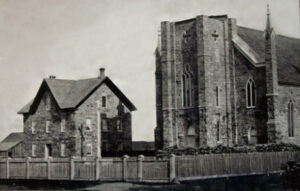
In the late 1880s when St. Joseph Catholic Church was built, it went without its steeple for quite some time until money could be raised to install one. To the left of the church is the parish house. The church, built by “sweat equity,’ was the first Catholic Church to be consecrated in Minnesota, in 1871.
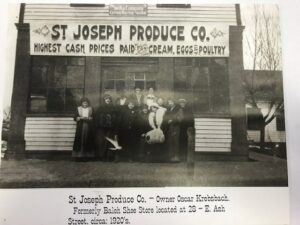
As the captions note, this store at 28 E. Ash Street was owned by Oscar Krebsbach.
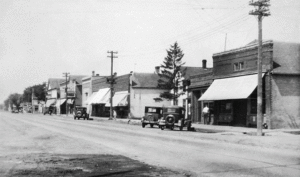
This is a photo of St. Joseph’s main street taken sometime in the 1930s.
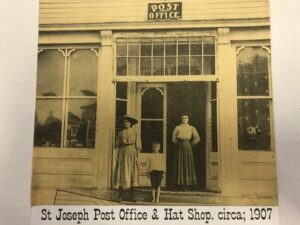
As the caption reveals, once upon a time St. Joseph had a post office combined with a hat shop. Hats were practically “mandatory” in the first years of the 20th Century.
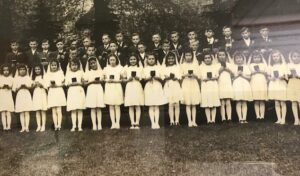
These are students who had just made their First Communion in one of the earliest classes of the St. Joseph Elementary School.
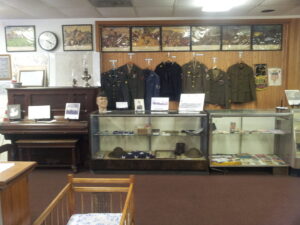
This photo was taken at the St. Joseph Area Historical Society’s second location, in the former city offices building at 25 First Ave. NW.




